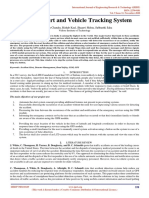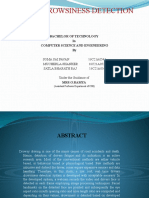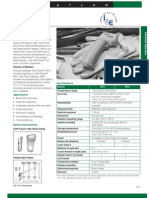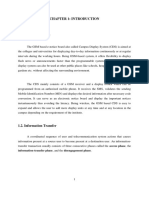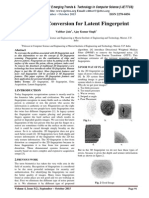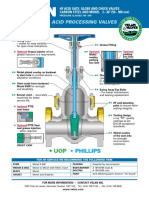Professional Documents
Culture Documents
Motion Object Detection Using Mean Square Error Method
Copyright
Available Formats
Share this document
Did you find this document useful?
Is this content inappropriate?
Report this DocumentCopyright:
Available Formats
Motion Object Detection Using Mean Square Error Method
Copyright:
Available Formats
Volume 2, Issue 5, May 2017 International Journal of Innovative Science and Research Technology
ISSN No: - 2456 - 2165
Motion Object Detection Using Mean Square Error
Method
Trupti K .Barsagade ,Prof .D. T. Salunke , Punam V. Bitake, Sandhya B. Kendre, Shubhangi J. Kambale
Information Technology, JSPMs Rajarshi Shahu College of Engineering,
Tathawade , Pune, Maharashtra, India
Abstract :- Smart CCTV (Closed-Circuit Television) it takes a simple picture of an image, this basic feature of
technology has increasingly been developed in the last few CCTV has been studied extensively [3]. The most importance
years to judge the situation and notify the administer or technique of this smart CCTV related research is to track and
take immediate action for security and surveillance analyze objects the images[4]. Thus, object-tracking
motives. Earlier, the Difference Method technology used to target the human subjects which has been
(FDM),Background Subtraction Method (BSM), and typically studied. The technology, which judge the current
Adaptive Background Subtraction Method (ABSM) is situation in real-time by analyzing the within behavioral
used for motion object detection but these methods could patterns of the objects and its association with the surrounding
not recognize rapid scene changes or an object does not environmental, has also been studied actively [5]. The core
move relatively for a long time. To solve such problem , we technology of smart CCTV analysis lies in detecting,
proposed a novel moving object detection method which analyzing, and tracking the objects motion[6]. However, the
showed high performance with regard to the MSE(Mean object, which is the target to be traced, can vary, depending on
Squared Error ) and the accuracy of detecting the moving the situation, such image size, orientation, and location, within
object contours compared to other existing methods. It consecutive frames. When the lights color or course as image
also reduces the time complexity and provides the size, orientation, and trace the item, as it is perceived as
accuracy .It is also good for observation of many places at another object, even though it is difficult to trace the item, as it
the same time with only a single CCTV system. is perceived as another object, even though it is same object as
in the previous frames [7].
Keywords - Motion Detection, Video Frame, Background
Difference, Embedded system Application. II. LITERATUR SURVEY
I. INTRODUCTION Motion object and Regional Detection Method using
Block-Based Background Difference Video Frame
quantitatively detectable moving object region by quickly
CCTV ordinance and its installation are progressively being creating a background image. This method could be used for
used in public facilities and organizations, as part of an effort cases that any background images does not exist or hard to be
to prevent child-related sexual offense or common place generated. This system is good for observation of many places
criminal acts. The environments monitoring has been at the same time with only a single CCTV system since it is
expanded to protect residents in places, such as elementary especially robust to abrupt scene changes.
schools and other care facilities, and city parks. This system
helps prevent crime and may aid in the solution of cases. Its It is impossible for human to monitoring every moment,
role is also increasing in various forms . The domestic CCTV hence smart surveillance system is required for completing
has been camera market in 2008 is increased by 1 trillion scalable smart video surveillance of inference framework in
Korean won, according to the 2010 Report on Mining and visual network is necessary.
Manufacturing issued by the Korea National Statistical office.
In addition, CCTV has been used for purpose , such as crime Hierarchical Ensemble of Background models for PTZ Based
prevention and the detection , influenced by the need for Video Surveillance system is based on the three components:
increased security. The British Market Research Firm IMSs background modeling, frame registration and object tracking.
2009 Worldwide CCTV and video Surveillance Equipment Hierarchical background model separate a continuous focal
Market Report expected that we would have approximately length of PTZ camera and partition it into fix length. In this
10% annual growth from $8.266 billion to $14.472 Billion in way PTZ camera capture images through registration and a
2014 [1]. CCTVs have been installed in places, such as public new robust feature is present for background modeling of each
places, where people often come and go, and government and every scene. Objects are tracking by using foreground
buildings, where security is required, as well as private extraction. The tracking outputs are feedback PTZ controller
residential areas [2].Thus, smart CCTV technology ,using by adjusting the camera. Properly to maintain the track object.
various attached sensors , judges the situation and notifies the
administrator directly or immediately responds. Additionally,
IJISRT17MY86 www.ijisrt.com 307
Volume 2, Issue 5, May 2017 International Journal of Innovative Science and Research Technology
ISSN No: - 2456 - 2165
III. PROPOSED SYSTEM It can store mobile numbers for all the administrators /
owners who need to be contacted in case of emergency.
A. System Architecture Also User can change camera using his mobile phone.
The system plays an alarm after detecting intrusion also
Fig.1 shows system Architecture for Motion Object Detection user can play it again and again using its mobile phone.
System
The system keeps track/log of all the activities. Hence
detailed record of messages received is maintained. Also
System can start and stop camera using Opens functions
a detailed track of all the activities (intrusion detection,
also video recording takes place using Opens.
etc.) is also maintained.
Image Comparison and Intrusion detection comparison-
The system only responds to owners mobile numbers.
block based motion object detection method.
Action received from any other mobiles will be rejected.
Fig 1.System Architecture for Motion Object Detection
IV. MATHEMATICAL MODEL C={C1,C2,C3 | C is the camera connected to PC
Let us consider S be a Systems such that C is the cameras connect to pc. There will be finite set of
cameras connected to system.
S= {U,C,V,I,T,AC,AL,Ds,Ss},
V={V1,V2,V3.....Van | V are the input videos used in the
where, system}
U= {U1, U2, U3.Un | U is a Set of all USERS } V is the videos used in the system. This video may increase
U is the users of the system. Users of the system may grow as day by day. This is infinite set.
the system is used by more and more people. User is infinite
set. I={I1,I2,I3.... In | I are the input images }
IJISRT17MY86 www.ijisrt.com 308
Volume 2, Issue 5, May 2017 International Journal of Innovative Science and Research Technology
ISSN No: - 2456 - 2165
I am the images used in the system. This video may increase IV. ALGORITHM
day by day. This is infinite set.
Step 1:Resize image 300*300.
T={T1,T2,T3 | T is the technique used to process Input image. Step 2: convert to gray scale image.
Formula
T is the technique used for image processing. This is a finite
set.
G(x,y) =0.299*Fr(x,y)+0.587*Fg(x,y)+0.114*Fb(x,y)
Ac={AC1,AC2,AC3 | AC is the action taken by system during Where,
intrusion} G gray scale
F frame image
AC is the action taken by the system in case of intrusion in r, g ,b it indicates Red, Green, Blue value,
video. Actions are finite set. respectively, to the pixel corresponding to the position of x
and y.
AL={A1,A2,A3...An | A is the audit log generated by the
system} Step 3: Divide the image into 5*5 block.
Formula Dn(x,y) = {1, |Wn(x,y) Bn(x,y)|>tr
0,
Each system event is captured as an audit log in system
otherwise
DS = {USERINFO, AUDITINFO, | DS is a Set of data table for Where (x,y = 0,1,2,3,N - 1)
permanent storing of data on server }
N window block size
SS = { Images, Videos | SS is a Set of Storage Service } n number of blocks
W block corresponding to the current image
STORAGE SERVER will provide services for storing videos B - block corresponding to the background image
and images. As this set also has finite attributes, so this is also D value of absolute difference between W and B
Finite Set.
Step 4: Comparing difference value with threshold value
USERINFO = { CUSTOMER_ID, Password, FULL_NAME,
Email ID, contact, DOB | USERINFO is a set for storing User if
Data }
difference value < threshold value = Environmental Change
AUDITINFO = { AUDIT_ID, message,datetime,camera_id |
else
AUDITINFO is a set for storing Audit}
Intrusion detected.
Fig 2 : flowchart of motion object detection algorithm
IJISRT17MY86 www.ijisrt.com 309
Volume 2, Issue 5, May 2017 International Journal of Innovative Science and Research Technology
ISSN No: - 2456 - 2165
V. EXPERIMENTAL RESULT background image but it uses a 24-bit image with R, G, B
values, and thus used grater capacity then that of FDM or
BSM that only store luminance value. The method proposed in
Figure 3 shows the average memory usage, the second this study divide the total memory usage into two parts:
performance evaluation criteria of the four methods used in storing the background image and storing the change rate by
this experiment. In the case of FDM and BSM most of the block. The background image used at this time stores only the
total memory usage was used to store the previous frame or a 8-bit luminance value, and the change rate by block requires
background image. At this time, the image information stored additional uses of memory block X 4-byte integer.
is simply an 8-bit luminance value of the color image, and Therefore, its memory usage is relatively more then for FDM
thus less memory was used then ABSM was used to store the and BSM but less than for ABSM.
Outside (a) Outside(b) Inside(c) Inside(d)
FDM 612.308 638.708 600.3 634.421
BSM 613.21 633.276 613.4344 634
ABSM 1409.45 1465.888 1321.02 13110992
MSE 909.1 912.342 902.7 920.12
Fig.3 avarage memory usage vs motion object detection system
VI. CONCLUSION REFERENCE
[1]A. Hayfield and G. Wong, The World Market for CCTV
This paper proposed an effective way using the MSE Method and VideoSurveillance Equipment,
of Motion Object Detection to reduce the memory usage and IMS Research, July, 2010.
time complexity. Firstly we studied FDM,BSM and ADBSM [2] Y. Cho, S. O. Lim, and H. S. Yang, Collaborative
method and then we proposed MSE algorithm. Finally ,we occupancy reasoningin visual sensor network for scalable
compared proposed system with existing system and the smart video surveillance,IEEETrans. Consumer Electro., vol.
experimental results show that the proposed method greatly 56, no. 3, pp. 1997-2003, 2010.
improved the accuracy of motion object detection system. [3] I. Ahmad, Z. He, M. Liao, F. Pereira, and M. T. Sun,
Effective motion detection performance was evaluated Special issue onvideo surveillance,IEEE Trans. Circuits
experimentally. The method proposed in this study did not System and Video Tech., vol.18, no. 8, pp. 1001-1005, 2008.
have much calculation in terms of arithmetic but showed a [4] A. Hampapur, L. Brown, J. Connell, A. Ekin, N. Hass, M.
slight inferiority compared to the other three methods in terms Lu, H.Merkl, S. Pankanti, A. Senior, C. Smartvideo
of processing time and memory usage to store change rate. surveillance: Exploring the concept of multistate
spatiotemporaltracking, IEEE Signal Proc. Magazine, vol. 22,
no. 2, pp. 38-51, 2005.
[5] H. Woo, Y. M. Jung, J. G. Kim, and J. K. Seo,
Environmentally Robust Motion Detection for Video
IJISRT17MY86 www.ijisrt.com 310
Volume 2, Issue 5, May 2017 International Journal of Innovative Science and Research Technology
ISSN No: - 2456 - 2165
Surveillance, IEEE Trans. Image Proc., vol.19, no. 11, pp. [19] R. I. Hartley and A. Zisserman, Multiple view geometry
2838-2848, 2010. in computer vision, 2nd ed. , Cambridge University Press,
[6] L. Li, W. Huang, I. Y. H. Gu, R. Luo, and Q. Tian, An Cambridge, 2004.
efficient sequential approach to tracking multiple objects
through crowds for real- time intelligent CCTV systems, [20] Ning Liu and Hefeng Wu, Hierarchical Ensemble of
IEEE Trans. Systems, Man, and Cyber., Part B: Cyber. , vol. Background Models for PTZ-Based Video Surveillance,
38, no. 5, pp. 1254-1269, 2008. IEEE TRANSATION ON CYBERNETICS, VOL. 45, NO. 1,
[7] J. Zhu, Y. Lao, and Y. F. Zheng, Object tracking in JANUARY 2015.
structured environments for video surveillance
applications,IEEE Trans. Circuits Systemand Video Tech., [21]T. Moeslund. A. Hilton A Survey of Advances in
vol. 20, no. 2, pp. 223-235, 2010. Vision-Based Human Motion Capture and Analysis ,
[8]Xiaowei Zhou and Can Yang, Moving Object Detection Computer Vision and Image Understanding, vol.104, nos. 2/3,
by Detecting Contiguous Outliersoin the Low-Rank pp.90-126,2006
Representation. IEEE TRANSACTION ON PATTERN
ANALYSIS AND MACHINE INTELLIGENCE, MARCH [22]C. Papageorgiou, M. Oren and T. Poggio, A General
2013. Framework for Object Detection ,Proc .IEEE intl Conf.
Computer Vision, p.555, 1998.
[9] A. Yilmaz, O. Javed, and M .Shah, Object Tracking: A
Survey, ACM Computing Surveys, vol. 38, no. 4, pp. 1-45, [23] G.G.S Menezes Motion Detection of Vehicles Based on
2006. FPGA, Proc. IEEE VI Souther Conference on Programmable
Logic (SPL), pp.151-154, Brazil, 2010
[10] T. Moeslund, A. Hilton, and V. Kruger, A Survey of
Advantage in Vision-Based Human Motion Capture and
Analysis, Computer Vision and Image Understanding, vol.
104, nos. 2/3 pp. 90-126, 2006.
[11] M. Oren and T. Poggio, A General Framework for
Object Detection Proc. IEEE IntI Conf. Computer Vision,
p.555, 1998.
[12] A. Hayfield and G. Wong, The World Market for CCTV
and Video Surveillance Equipment, IMS Research, July,
2010.
[13] Y. Cho, S. O. Lim, Collaborative occupancy reasoning
in visual sensor network for scalable smart video
surveillance, IEEE Trans. Consumer Electro, vol. 56, no. 3,
pp. 1997-2003, 2010.
[15] M. Liao, F. Pereira, and M. T. sun, Special issue on
video surveillance, IEEE Trans. Circuits System and Video
Tech, vol. 18, no. 8, pp. 1001-1005, 2008.
[16] Yongil Cho and Sang Ok Lim, Collaborative Occupancy
Reasoning in Visual Sensor Network for Scalable Smart
Video Surveillance IEEE Transaction on Consumer
Electronics, Vol. 56, No.3, August 2010.
[17] S. Soro and W. Heinzelman, A survey of visual sensor
networks , Advances in Multimedia, vol. 2009, pp. 21,
Article ID 640386, 2009.
[18] M. Quaritsch and W. Wolf, The evolution from single to
pervasive smart cameras, In Proc of IEEE International
Conference on Distributed Smart Cameras, pp. 1-10, 2008.
IJISRT17MY86 www.ijisrt.com 311
You might also like
- Object Motion Detection in Video Frames Using Background Frame MatchingDocument4 pagesObject Motion Detection in Video Frames Using Background Frame MatchingseventhsensegroupNo ratings yet
- Trends & Issues: How Do Police Use CCTV Footage in Criminal Investigations?Document15 pagesTrends & Issues: How Do Police Use CCTV Footage in Criminal Investigations?Joaquin Raphael ArcajoNo ratings yet
- Motion Blur Detection and Removal in ImagesDocument3 pagesMotion Blur Detection and Removal in ImagesInternational Journal of Innovative Science and Research TechnologyNo ratings yet
- Chapter 2 - Literature Reviews: 2.1 Application of Electronic in AutomotiveDocument23 pagesChapter 2 - Literature Reviews: 2.1 Application of Electronic in AutomotiveMuhamad AdibNo ratings yet
- Iot Based Anti Theift Flooring SystemDocument9 pagesIot Based Anti Theift Flooring Systembabblubabblu295No ratings yet
- Moving Object Detection Using Matlab PDFDocument7 pagesMoving Object Detection Using Matlab PDFChetan Turkane100% (2)
- A+b Iot Based Anti Theft Flooring System Using Raspberry PiDocument1 pageA+b Iot Based Anti Theft Flooring System Using Raspberry Pisunkara nagendra kumarNo ratings yet
- Unit 4 Architectural Approach For IoTDocument14 pagesUnit 4 Architectural Approach For IoTtrupti.kodinariya98100% (1)
- Image Processing in Road Traf C AnalysisDocument11 pagesImage Processing in Road Traf C AnalysisAshwiini Vigna BasuthkarNo ratings yet
- Image Segmentation For Object Detection Using Mask R-CNN in ColabDocument5 pagesImage Segmentation For Object Detection Using Mask R-CNN in ColabGRD JournalsNo ratings yet
- Accident Alert and Vehicle Tracking System IJERTV9IS110129Document5 pagesAccident Alert and Vehicle Tracking System IJERTV9IS110129Tawan JimNo ratings yet
- Design and Implementation of Pothole Detector Usingmultisensor System PDFDocument5 pagesDesign and Implementation of Pothole Detector Usingmultisensor System PDFChethan GowdaNo ratings yet
- Final Project NewDocument38 pagesFinal Project NewTanveer Wani100% (1)
- Examination SurveillanceDocument13 pagesExamination SurveillanceAsimobi Nnaemeka DanielNo ratings yet
- Research ProposalDocument1 pageResearch ProposalSowmitraDasNo ratings yet
- Border Security Using Wireless Integrated Network Sensors (WINS)Document18 pagesBorder Security Using Wireless Integrated Network Sensors (WINS)Pradeep CheekatlaNo ratings yet
- Vehicle Anti-Collision Using Ultrasonic SignalsDocument22 pagesVehicle Anti-Collision Using Ultrasonic SignalsAakash GuptaNo ratings yet
- Autonomous Pedestrian Collision Avoidance Using A Fuzzy Steering ControllerDocument12 pagesAutonomous Pedestrian Collision Avoidance Using A Fuzzy Steering ControllerSundar C EceNo ratings yet
- Traffic Object Detection Literature SurveyDocument8 pagesTraffic Object Detection Literature SurveyperumalvigneshNo ratings yet
- Finger-Vein Based Biometric Security SystemDocument4 pagesFinger-Vein Based Biometric Security SystemInternational Journal of Research in Engineering and TechnologyNo ratings yet
- Fast and accurate object detection models for computer vision tasksDocument4 pagesFast and accurate object detection models for computer vision tasksnamanNo ratings yet
- Motion DetectionDocument33 pagesMotion DetectionChetan TurkaneNo ratings yet
- A Study of Cybercrimes in India Using Digital ForensicsDocument15 pagesA Study of Cybercrimes in India Using Digital ForensicsIJRASETPublicationsNo ratings yet
- Crashless cars seminarDocument2 pagesCrashless cars seminarsourabh ChoudhuryNo ratings yet
- Activity Tracker Wrist Band For Children Monitoring Using IOTDocument8 pagesActivity Tracker Wrist Band For Children Monitoring Using IOTAnonymous lPvvgiQjRNo ratings yet
- 0TH ReviewDocument10 pages0TH ReviewAkash KamalNo ratings yet
- Brain Finger Printing TechnologyDocument12 pagesBrain Finger Printing Technologypinks_dollsNo ratings yet
- Iot Assignment - 1: Manhole Detection and Monitoring SystemDocument5 pagesIot Assignment - 1: Manhole Detection and Monitoring Systemj abhishekNo ratings yet
- Drowsiness Detection System Using Machine LearningDocument4 pagesDrowsiness Detection System Using Machine LearningNIET Journal of Engineering & Technology(NIETJET)No ratings yet
- Group13 Ecea200-1l FinalmanuscriptDocument57 pagesGroup13 Ecea200-1l FinalmanuscriptKim Andre MacaraegNo ratings yet
- Wireless Networks Seminar Report and TopicDocument32 pagesWireless Networks Seminar Report and TopicAnkit KumarNo ratings yet
- Single Shot DetectionDocument8 pagesSingle Shot DetectionDaniel FleuryNo ratings yet
- Detecting Fake Images Using Demosaicing AlgorithmsDocument5 pagesDetecting Fake Images Using Demosaicing AlgorithmsShaletXavierNo ratings yet
- Accident Protection System Using Electromagnetic Abs Braking SystemDocument26 pagesAccident Protection System Using Electromagnetic Abs Braking SystemCODING CHANNELNo ratings yet
- Intelligent Driving System: Bachelor of TechnologyDocument20 pagesIntelligent Driving System: Bachelor of TechnologyRajaNo ratings yet
- Driver'S Drowsiness Detection System: Bachelor of Technology in Computer Science and Engineering byDocument18 pagesDriver'S Drowsiness Detection System: Bachelor of Technology in Computer Science and Engineering byShanker Yadav0% (1)
- A Review On Deep Learning ApplicationsDocument11 pagesA Review On Deep Learning ApplicationsDr.Chitra DhawaleNo ratings yet
- On-Road Animal Collision Mitigation Using CNNDocument40 pagesOn-Road Animal Collision Mitigation Using CNNCosmk1ng Zero-1No ratings yet
- Fingerprint Voting System: A Promising Technology for Secure ElectionsDocument22 pagesFingerprint Voting System: A Promising Technology for Secure Electionsvisit4tehnicalNo ratings yet
- Infrared Sensors Hand HeldDocument5 pagesInfrared Sensors Hand HeldEliasNo ratings yet
- Different Approaches To Crack Monitoring of Buildings Using IOTDocument11 pagesDifferent Approaches To Crack Monitoring of Buildings Using IOTIJRASETPublicationsNo ratings yet
- Patent, Right, Creation and Regitration 1Document102 pagesPatent, Right, Creation and Regitration 1Juhi SaxenaNo ratings yet
- IOT Based Home Security SystemDocument7 pagesIOT Based Home Security SystemS Jagadish PatilNo ratings yet
- Design and Implementation of A Mini-Size Search Robot PDFDocument4 pagesDesign and Implementation of A Mini-Size Search Robot PDFsrcembeddedNo ratings yet
- CCTV SonarDocument13 pagesCCTV SonarAlexandru AndreiNo ratings yet
- Smart Notice BoardDocument42 pagesSmart Notice BoardDhiraj BhattNo ratings yet
- Comparison of Data Encryption AlgorithmsDocument3 pagesComparison of Data Encryption Algorithmskartikrathod10No ratings yet
- Cse Diamond Chip Reportn PDFDocument18 pagesCse Diamond Chip Reportn PDFSanjay Kumar PrajapatiNo ratings yet
- Computerised Crime Tracking Information SystemDocument11 pagesComputerised Crime Tracking Information SystemDinomarshal Pezum100% (1)
- 3D To 2D: Conversion For Latent FingerprintDocument3 pages3D To 2D: Conversion For Latent FingerprintInternational Journal of Application or Innovation in Engineering & ManagementNo ratings yet
- 05 Phillips CCTV EvaluationsDocument33 pages05 Phillips CCTV EvaluationsJhon ChristianNo ratings yet
- Digital Image Forgery DetectionDocument25 pagesDigital Image Forgery DetectionAli BabarNo ratings yet
- Patient Monitoring System Using GSM For Hospitals and Old Age HomesDocument5 pagesPatient Monitoring System Using GSM For Hospitals and Old Age Homesvgmanjunatha100% (1)
- Object Detection Using Convolution Al Neural NetworksDocument6 pagesObject Detection Using Convolution Al Neural NetworksAnita JaiswalNo ratings yet
- Smart Stick For Blind Using Machine LearningDocument7 pagesSmart Stick For Blind Using Machine LearningAnonymous izrFWiQNo ratings yet
- Vehicle Detection For Accident PreventionDocument7 pagesVehicle Detection For Accident PreventionIJRASETPublicationsNo ratings yet
- Synopsis Object DetectionDocument7 pagesSynopsis Object Detectionkartik sangNo ratings yet
- Micro Controller Based Power Theft IdentificationDocument16 pagesMicro Controller Based Power Theft Identificationmoon403100% (1)
- Intelligent Video Surveillance System Architecture For Abnormal Activity DetectionDocument10 pagesIntelligent Video Surveillance System Architecture For Abnormal Activity DetectionMaitanmi Sola StephenNo ratings yet
- Abnormal Vehicle Behavior Detection Using Deep Learning and Computer VisionDocument8 pagesAbnormal Vehicle Behavior Detection Using Deep Learning and Computer VisionInternational Journal of Innovative Science and Research TechnologyNo ratings yet
- The Making of Self-Disposing Contactless Motion-Activated Trash Bin Using Ultrasonic SensorsDocument7 pagesThe Making of Self-Disposing Contactless Motion-Activated Trash Bin Using Ultrasonic SensorsInternational Journal of Innovative Science and Research TechnologyNo ratings yet
- Exploring the Clinical Characteristics, Chromosomal Analysis, and Emotional and Social Considerations in Parents of Children with Down SyndromeDocument8 pagesExploring the Clinical Characteristics, Chromosomal Analysis, and Emotional and Social Considerations in Parents of Children with Down SyndromeInternational Journal of Innovative Science and Research TechnologyNo ratings yet
- Intelligent Engines: Revolutionizing Manufacturing and Supply Chains with AIDocument14 pagesIntelligent Engines: Revolutionizing Manufacturing and Supply Chains with AIInternational Journal of Innovative Science and Research TechnologyNo ratings yet
- Advancing Opthalmic Diagnostics: U-Net for Retinal Blood Vessel SegmentationDocument8 pagesAdvancing Opthalmic Diagnostics: U-Net for Retinal Blood Vessel SegmentationInternational Journal of Innovative Science and Research TechnologyNo ratings yet
- Handling Disruptive Behaviors of Students in San Jose National High SchoolDocument5 pagesHandling Disruptive Behaviors of Students in San Jose National High SchoolInternational Journal of Innovative Science and Research TechnologyNo ratings yet
- Natural Peel-Off Mask Formulation and EvaluationDocument6 pagesNatural Peel-Off Mask Formulation and EvaluationInternational Journal of Innovative Science and Research TechnologyNo ratings yet
- Beyond Shelters: A Gendered Approach to Disaster Preparedness and Resilience in Urban CentersDocument6 pagesBeyond Shelters: A Gendered Approach to Disaster Preparedness and Resilience in Urban CentersInternational Journal of Innovative Science and Research TechnologyNo ratings yet
- Placement Application for Department of Commerce with Computer Applications (Navigator)Document7 pagesPlacement Application for Department of Commerce with Computer Applications (Navigator)International Journal of Innovative Science and Research TechnologyNo ratings yet
- Fruit of the Pomegranate (Punica granatum) Plant: Nutrients, Phytochemical Composition and Antioxidant Activity of Fresh and Dried FruitsDocument6 pagesFruit of the Pomegranate (Punica granatum) Plant: Nutrients, Phytochemical Composition and Antioxidant Activity of Fresh and Dried FruitsInternational Journal of Innovative Science and Research TechnologyNo ratings yet
- A Knowledg Graph Model for e-GovernmentDocument5 pagesA Knowledg Graph Model for e-GovernmentInternational Journal of Innovative Science and Research TechnologyNo ratings yet
- REDLINE– An Application on Blood ManagementDocument5 pagesREDLINE– An Application on Blood ManagementInternational Journal of Innovative Science and Research TechnologyNo ratings yet
- Pdf to Voice by Using Deep LearningDocument5 pagesPdf to Voice by Using Deep LearningInternational Journal of Innovative Science and Research TechnologyNo ratings yet
- A Curious Case of QuadriplegiaDocument4 pagesA Curious Case of QuadriplegiaInternational Journal of Innovative Science and Research TechnologyNo ratings yet
- Safety, Analgesic, and Anti-Inflammatory Effects of Aqueous and Methanolic Leaf Extracts of Hypericum revolutum subsp. kenienseDocument11 pagesSafety, Analgesic, and Anti-Inflammatory Effects of Aqueous and Methanolic Leaf Extracts of Hypericum revolutum subsp. kenienseInternational Journal of Innovative Science and Research TechnologyNo ratings yet
- Analysis of Financial Ratios that Relate to Market Value of Listed Companies that have Announced the Results of their Sustainable Stock Assessment, SET ESG Ratings 2023Document10 pagesAnalysis of Financial Ratios that Relate to Market Value of Listed Companies that have Announced the Results of their Sustainable Stock Assessment, SET ESG Ratings 2023International Journal of Innovative Science and Research TechnologyNo ratings yet
- Food habits and food inflation in the US and India; An experience in Covid-19 pandemicDocument3 pagesFood habits and food inflation in the US and India; An experience in Covid-19 pandemicInternational Journal of Innovative Science and Research TechnologyNo ratings yet
- Adoption of International Public Sector Accounting Standards and Quality of Financial Reporting in National Government Agricultural Sector Entities, KenyaDocument12 pagesAdoption of International Public Sector Accounting Standards and Quality of Financial Reporting in National Government Agricultural Sector Entities, KenyaInternational Journal of Innovative Science and Research TechnologyNo ratings yet
- Improvement Functional Capacity In Adult After Percutaneous ASD ClosureDocument7 pagesImprovement Functional Capacity In Adult After Percutaneous ASD ClosureInternational Journal of Innovative Science and Research TechnologyNo ratings yet
- Design and Implementation of Homemade Food Delivery Mobile Application Using Flutter-FlowDocument7 pagesDesign and Implementation of Homemade Food Delivery Mobile Application Using Flutter-FlowInternational Journal of Innovative Science and Research TechnologyNo ratings yet
- Machine Learning and Big Data Analytics for Precision Cardiac RiskStratification and Heart DiseasesDocument6 pagesMachine Learning and Big Data Analytics for Precision Cardiac RiskStratification and Heart DiseasesInternational Journal of Innovative Science and Research TechnologyNo ratings yet
- Optimization of Process Parameters for Turning Operation on D3 Die SteelDocument4 pagesOptimization of Process Parameters for Turning Operation on D3 Die SteelInternational Journal of Innovative Science and Research TechnologyNo ratings yet
- Design and Development of Controller for Electric VehicleDocument4 pagesDesign and Development of Controller for Electric VehicleInternational Journal of Innovative Science and Research TechnologyNo ratings yet
- The Students’ Assessment of Family Influences on their Academic MotivationDocument8 pagesThe Students’ Assessment of Family Influences on their Academic MotivationInternational Journal of Innovative Science and Research Technology100% (1)
- Forensic Evidence Management Using Blockchain TechnologyDocument6 pagesForensic Evidence Management Using Blockchain TechnologyInternational Journal of Innovative Science and Research TechnologyNo ratings yet
- Scrolls, Likes, and Filters: The New Age Factor Causing Body Image IssuesDocument6 pagesScrolls, Likes, and Filters: The New Age Factor Causing Body Image IssuesInternational Journal of Innovative Science and Research TechnologyNo ratings yet
- Severe Residual Pulmonary Stenosis after Surgical Repair of Tetralogy of Fallot: What’s Our Next Strategy?Document11 pagesSevere Residual Pulmonary Stenosis after Surgical Repair of Tetralogy of Fallot: What’s Our Next Strategy?International Journal of Innovative Science and Research TechnologyNo ratings yet
- Late Presentation of Pulmonary Hypertension Crisis Concurrent with Atrial Arrhythmia after Atrial Septal Defect Device ClosureDocument12 pagesLate Presentation of Pulmonary Hypertension Crisis Concurrent with Atrial Arrhythmia after Atrial Septal Defect Device ClosureInternational Journal of Innovative Science and Research TechnologyNo ratings yet
- Enhancing Biometric Attendance Systems for Educational InstitutionsDocument7 pagesEnhancing Biometric Attendance Systems for Educational InstitutionsInternational Journal of Innovative Science and Research TechnologyNo ratings yet
- Blockchain-Enabled Security Solutions for Medical Device Integrity and Provenance in Cloud EnvironmentsDocument13 pagesBlockchain-Enabled Security Solutions for Medical Device Integrity and Provenance in Cloud EnvironmentsInternational Journal of Innovative Science and Research TechnologyNo ratings yet
- The Experiences of Non-PE Teachers in Teaching First Aid and Emergency Response: A Phenomenological StudyDocument89 pagesThe Experiences of Non-PE Teachers in Teaching First Aid and Emergency Response: A Phenomenological StudyInternational Journal of Innovative Science and Research TechnologyNo ratings yet
- Heliobond GI WE3Document24 pagesHeliobond GI WE3jarodzeeNo ratings yet
- DISCOVERY SP-ENG V. 0.6 - Leonali 1463Document30 pagesDISCOVERY SP-ENG V. 0.6 - Leonali 1463Hanz RodriguezNo ratings yet
- The Existence of An External Redundancy ASM DiskgroupDocument55 pagesThe Existence of An External Redundancy ASM Diskgroupsidd_aish@yahoo.comNo ratings yet
- Ktu Laca Solved Question PaperDocument22 pagesKtu Laca Solved Question PaperSofiyaNo ratings yet
- Costiuc Silvia - Culas in Oltenia - CNHC 2011Document25 pagesCostiuc Silvia - Culas in Oltenia - CNHC 2011trancalina100% (1)
- Projection Achievement ReportDocument8 pagesProjection Achievement ReportPskaruppiah KarupsNo ratings yet
- Introduction To Soil MechanicsDocument20 pagesIntroduction To Soil MechanicsMaeen AhmedNo ratings yet
- Pai Ch03 ArrayDocument33 pagesPai Ch03 ArrayanonNo ratings yet
- Astm B187Document9 pagesAstm B187Plata Elpidio100% (3)
- Underfloor Wheelset Lathe: Operating / Maintenance ManualDocument84 pagesUnderfloor Wheelset Lathe: Operating / Maintenance ManualMinh Canh100% (1)
- 10.4 Modes of TransportDocument12 pages10.4 Modes of TransportAya Magdy AhmedNo ratings yet
- XT316 Air SockerDocument4 pagesXT316 Air Sockeryudiar djamaldilliahNo ratings yet
- PW DebugDocument2 pagesPW DebugAimeeFieldsNo ratings yet
- HF Acid Processing Valves Technical SpecificationsDocument4 pagesHF Acid Processing Valves Technical Specificationssemarasik_651536604No ratings yet
- GEOtouch®PET NEEDLE-PUNCHED NONWOVEN GEOTEXTILEDocument1 pageGEOtouch®PET NEEDLE-PUNCHED NONWOVEN GEOTEXTILEManas Kumar SamalNo ratings yet
- Heat Exchangers: T T T TDocument11 pagesHeat Exchangers: T T T Tcjc0706No ratings yet
- 6T40 45 Diag FixesDocument69 pages6T40 45 Diag Fixesjosue100% (12)
- Physics 110A: Electromagnetism: 1 Introduction and OverviewDocument4 pagesPhysics 110A: Electromagnetism: 1 Introduction and OverviewJoshua LinNo ratings yet
- Super Seal II Float Shoe Nose Options: CementingDocument4 pagesSuper Seal II Float Shoe Nose Options: CementingJuan Miguel RobledoNo ratings yet
- PE - EXAM GUIDE Signalization WarrantsDocument12 pagesPE - EXAM GUIDE Signalization WarrantsRoberto CatalaniNo ratings yet
- Drum Unloading SystemDocument2 pagesDrum Unloading SystemJas SumNo ratings yet
- Bms & Hvac SystemDocument41 pagesBms & Hvac SystemHirushan Menuka100% (2)
- Durehete 1055Document5 pagesDurehete 1055alextentwenty100% (1)
- Competency-Check-H e I ADocument20 pagesCompetency-Check-H e I Abaldo yellow4No ratings yet
- Compressed Air Fittings & Equipment Catalogue: Importers and Direct Sellers of Quality Hand ToolsDocument18 pagesCompressed Air Fittings & Equipment Catalogue: Importers and Direct Sellers of Quality Hand ToolsVin KenNo ratings yet
- A Triangle Area Based Nearest Neighbors Approach To Intrusion DetectionDocument8 pagesA Triangle Area Based Nearest Neighbors Approach To Intrusion DetectionHomeed AlzhraniNo ratings yet
- MPC6515 ManualDocument37 pagesMPC6515 ManualJerome CeleraNo ratings yet
- Saudi Technical Trade Test - Welder CategoryDocument4 pagesSaudi Technical Trade Test - Welder CategoryshabashakkimNo ratings yet
- Project Title: TBA: Client: ContractorDocument4 pagesProject Title: TBA: Client: ContractorIzza Halim100% (2)
- NCP1117, NCV1117Document17 pagesNCP1117, NCV1117kalimbaloNo ratings yet










